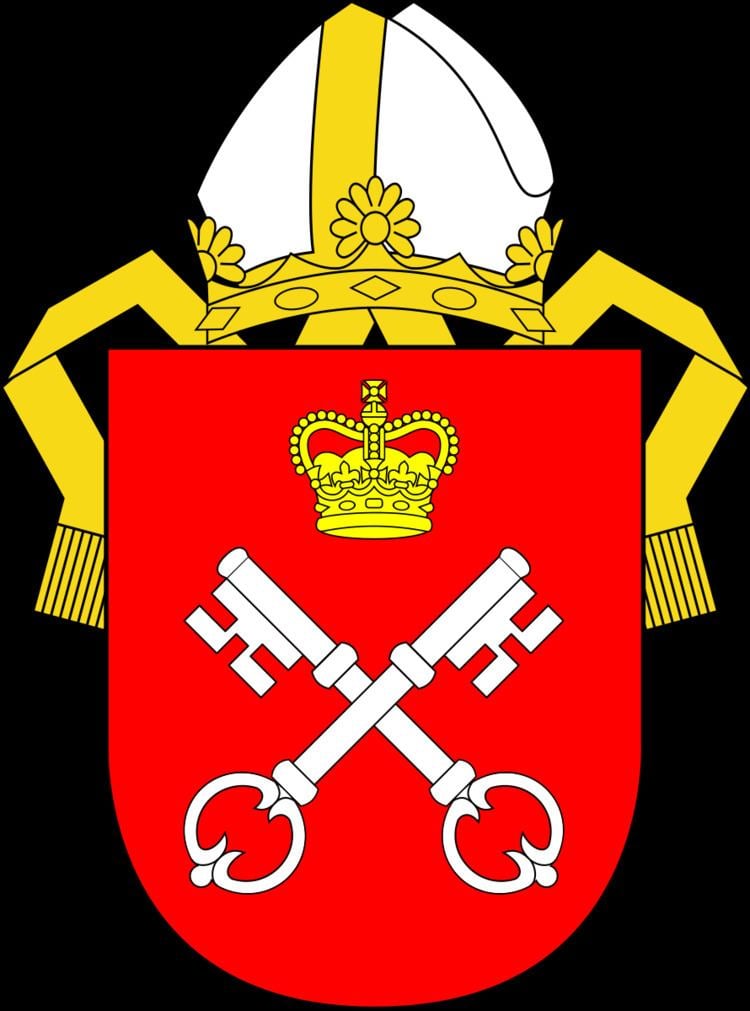Diocese York | ||
 | ||
Style The Most Revd and Rt Hon | ||
The Archbishop of York is a senior bishop in the Church of England, second only to the Archbishop of Canterbury. The archbishop is the diocesan bishop of the Diocese of York and the metropolitan bishop of the Province of York, which covers the northern regions of England (north of the Trent) as well as the Isle of Man. The Archbishop of York is an ex officio member of the House of Lords and is styled Primate of England (the Archbishop of Canterbury is the "Primate of All England").
Contents
The archbishop's throne (cathedra) is in York Minster in central York and his official residence is Bishopthorpe Palace in the village of Bishopthorpe outside of York. The incumbent, from 5 October 2005, is John Sentamu who signs as +Sentamu Ebor: (since both John and Sentamu are his forenames).
Six of the early Bishops of York and one Archibishop (William of York) were ultimately canonised by the Roman Catholic Church, and five more historically recent Archbishops ultimately achieved the supreme Archbishopric of Canterbury.
Roman
There was a bishop in Eboracum (Roman York) from very early times; during the Middle Ages, it was thought to have been one of the dioceses established by the legendary King Lucius. Bishops of York are known to have been present at the Councils of Arles (Eborius) and Nicaea (unnamed). However, this early Christian community was later destroyed by the pagan Anglo-Saxons and there is no direct succession from these bishops to the post-Augustinian ones.
Saxon, Viking and Medieval times
The diocese was refounded by Paulinus (a member of Augustine's mission) in the 7th century. Notable among these early bishops is Wilfrid. These early bishops of York acted as diocesan rather than archdiocesan prelates until the time of Ecgbert of York, who received the pallium from Pope Gregory III in 735 and established metropolitan rights in the north. Until the Danish invasion the archbishops of Canterbury occasionally exercised authority, and it was not till the Norman Conquest that the archbishops of York asserted their complete independence.
At the time of the Norman invasion York had jurisdiction over Worcester, Lichfield, and Lincoln, as well as the dioceses in the Northern Isles and Scotland. But the first three sees just mentioned were taken from York in 1072. In 1154 the suffragan sees of the Isle of Man and Orkney were transferred to the Norwegian archbishop of Nidaros (today's Trondheim), and in 1188 all the Scottish dioceses except Whithorn were released from subjection to York, so that only the dioceses of Whithorn, Durham, and Carlisle remained to the Archbishops as suffragan sees. Of these, Durham was practically independent, for the palatine bishops of that see were little short of sovereigns in their own jurisdiction. Sodor and Man were returned to York during the fourteenth century, to compensate for the loss of Whithorn to the Scottish Church.
Several of the archbishops of York held the ministerial office of Lord Chancellor of England and played some parts in affairs of state. As Peter Heylyn (1600–1662) wrote: "This see has yielded to the Church eight saints, to the Church of Rome three cardinals, to the realm of England twelve Lord Chancellors and two Lord Treasurers, and to the north of England two Lord Presidents." The bishopric's role was also complicated by continued conflict over primacy with the see of Canterbury.
English Reformation
At the time of the English Reformation, York possessed three suffragan sees, Durham, Carlisle and Sodor and Man, to which during the brief space of Queen Mary I's reign (1553–1558) may be added the Diocese of Chester, founded by Henry VIII, but subsequently recognised by the Pope.
Until the mid 1530s (and from 1553-1558) the bishops and archbishops were in communion with the pope in Rome. This is no longer the case, as the Archbishop of York, together with the rest of the Church of England, is a member of the Anglican Communion.
Walter de Grey purchased York Place as his London residence, which after the fall of Cardinal Thomas Wolsey, was renamed the Palace of Whitehall.
Present
The Archbishop of York is the metropolitan bishop of the Province of York and is the junior of the two archbishops of the Church of England after the Archbishop of Canterbury. Since 5 October 2005, the incumbent is the Most Reverend John Sentamu who is also an ex officio member of the House of Lords.
The Province of York includes 10 Anglican dioceses in Northern England: Blackburn, Carlisle, Chester, Durham, Liverpool, Manchester, Newcastle, Sheffield, Leeds, and York, as well as 2 other dioceses: Southwell and Nottingham in the Midlands and Sodor and Man covering the Isle of Man.
